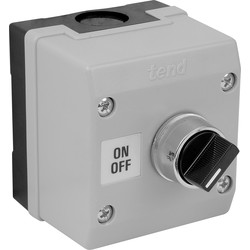DonJohnson
Established Member
I recently purchased the DK6683 Chip & Dust Extractor from Rutlands, and it has reduced the sawdust mess in my garage workshop considerably.
The only negative aspect - for me - is that it is fitted with a NVR (No Volt Relay) switch, with the familiar red and green buttons and panic 'off' cover. This means I have to move from my table saw to the dust extractor just as I have got the saw set up for a cut, to switch it on - and leave the saw again after the cut to switch it off.
I prefer to switch the extractor remotely.
So, WITH THE MAINS DISCONNECTED, I removed the two screws securing the NVR unit, which could then be pulled out slightly so as to see the connections. There are a pair of blue wires, and a pair of red/brown wires, which were pushed onto connections in the NVR using 1/4 inch Lucas spade-type connectors. I pulled these four spades connectors off the NVR.
I obtained some of the male versions of these spade connectors - the insulated type - and crimped them onto the ends of two lengths of about 2 inches of of wire, one blue and one brown, taken from 5A flexible mains cable. The brown one was used to connect together the two red/brown wires on the dust extractor, and the blue one the two blue wires. I ensured that the male connectors were pushed right into the spades so that they were covered by the insulated boots on each spade. There was room in the housing to push the linked wires inside, and then to fit the NVR back with its two screws. The body of the NVR and the recess in which it lives is all made of plastic, so there is little chance of any shorts occurring if the connections are made carefully. As expected, the extractor then started up immediately its plug was inserted into a mains socket.
To provide remote control, I used a remote 13A switchable socket I purchased from Lidl some years ago. The switchable socket plugs into a mains socket, and the extractor plug goes into it in turn. I can now leave the switchable socket control on the saw (or in my pocket), and operate it from the saw (or other machine) without having to go to the extractor. Similar products to my Lidl version can be found on EBay (Remote Control Socket Wireless Switch Home Mains UK Plug AC Power Energy Outlet) for about £6.50.
I hope that this may be helpful to others, but the above explanation of the procedures I undertook are best carried out by someone qualified to deal with electrics, and I take no responsibility for any accidents occurring to persons who follow them but are not competent to know what they are doing.
The only negative aspect - for me - is that it is fitted with a NVR (No Volt Relay) switch, with the familiar red and green buttons and panic 'off' cover. This means I have to move from my table saw to the dust extractor just as I have got the saw set up for a cut, to switch it on - and leave the saw again after the cut to switch it off.
I prefer to switch the extractor remotely.
So, WITH THE MAINS DISCONNECTED, I removed the two screws securing the NVR unit, which could then be pulled out slightly so as to see the connections. There are a pair of blue wires, and a pair of red/brown wires, which were pushed onto connections in the NVR using 1/4 inch Lucas spade-type connectors. I pulled these four spades connectors off the NVR.
I obtained some of the male versions of these spade connectors - the insulated type - and crimped them onto the ends of two lengths of about 2 inches of of wire, one blue and one brown, taken from 5A flexible mains cable. The brown one was used to connect together the two red/brown wires on the dust extractor, and the blue one the two blue wires. I ensured that the male connectors were pushed right into the spades so that they were covered by the insulated boots on each spade. There was room in the housing to push the linked wires inside, and then to fit the NVR back with its two screws. The body of the NVR and the recess in which it lives is all made of plastic, so there is little chance of any shorts occurring if the connections are made carefully. As expected, the extractor then started up immediately its plug was inserted into a mains socket.
To provide remote control, I used a remote 13A switchable socket I purchased from Lidl some years ago. The switchable socket plugs into a mains socket, and the extractor plug goes into it in turn. I can now leave the switchable socket control on the saw (or in my pocket), and operate it from the saw (or other machine) without having to go to the extractor. Similar products to my Lidl version can be found on EBay (Remote Control Socket Wireless Switch Home Mains UK Plug AC Power Energy Outlet) for about £6.50.
I hope that this may be helpful to others, but the above explanation of the procedures I undertook are best carried out by someone qualified to deal with electrics, and I take no responsibility for any accidents occurring to persons who follow them but are not competent to know what they are doing.





